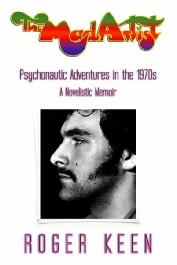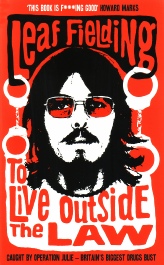
William J Booker
Reviews 2
state within the painter’, others ‘evoking nightmarish and trip-like states’.
Stoked by Leb and black, listening to Stan Getz’s sax, Keen gives a splendid description of a dope vision, ‘... a helter-skelter ride that speeded up crazily till it twisted itself into a drill bit, hurling out great red meteorites, each exploding right up close, the debris turning into skyrockets, spaceships, satellites, shooting stars, flying saucers, before dissolving into a crisscross of rainbows, which lay flat to become the etched surface of an ice rink, covered in skaters inscribing beautiful geometric designs...’ (p171)
During his time in student halls, Roger relates the tale of two of his fellow students indulging in a dick-swinging contest as they attempt to out-do each other with the size of their home-made bongs:
‘Race had had his Courvoisier bong trumped by Sam‘s belljar...’ (p207)
The Big Trip that opens Chapter 34 (p237) is beautiful and well-written. ‘There‘s a finality about dropping a large dose of acid.’ This is what an outdoor trip is all about and all looks set for a fair wind and a following sea, which is indeed the case - until the dialogue between Roger and Henry becomes disconnected (not unusual during trips), leading Roger to suspect his friend of deliberate obtuseness, keeping himself ‘one step ahead’, sabotaging the wonderful interchange of previous occasions:
‘“Tell me, Henry, do you know something I don‘t?”’
‘Henry didn’t reply and that silence barrier descended again like a steel shutter.’ (p243)
This signifies an early indication of fundamental changes in their friendship which are dealt with in the subsequent narrative.
Much later, during a mushroom trip, Roger seeks out his friend Henry to explain a particularly significant transformation he‘s undergoing. ‘“Blimey,” [Henry] said at last. “You’re telling me that you’ve become a Butterfly... I think we’d better get a cup of tea.”’ (p352)
The whole story is a delight from beginning to end. He describes his exploits on and off campus, the sex, the trials and politics of student life, a trip to a Stonehenge festival, crazy nights in and out with best friend Henry. There is a thread running through the narrative dealing with ‘Geometric Progressions’ (Keen’s term for his spiritual development) that leads to some very interesting musings and conclusions towards the end.
Heightened perception. Altered states. Philosophical musings. Enlightenment.
Regardless of the ‘Tee hee!’ from my pixies and pirates and ‘Heh heh!’ from Roger’s ‘The Man’, this is le fromage sacré véritable...
As Andy Roberts writes in his review of my book, Trippers, ‘We [...] thought we were individual, yet take a look down the time tunnel [...] - we were conformists after all! But what a conformity it was!’ We thought we were unique in our adventures and experiments, delving into little-known regions of liminal reality, but in fact it seems that on any particular day or night there were (and hopefully still are) legions of intrepid trippers slipping into multidimensional realities. Whether indoors with candles, incense and hi-fi speakers or out in the woods and fields, by rivers and lakes, in graveyards and ruined castles, racking up experiences that ‘outsiders’ could never believe, experiences that have brought about deep and lasting changes in their psyches (in out of the way places or transmogrifying in plain sight) - in short this land is aswarm with these magicians.
Roger has said that in a parallel universe the two of us are possibly the same person - there are numerous instances where The Mad Artist and my book, Trippers, connect, even though the former spans four years and the latter just a few weeks - and I wouldn’t disagree with him in principle, but consider this: an observer looking down upon the British Isles from a celestial vantage point may well see a myriad coloured lights twinkling in the darkness and those lights may well represent The Semi Secret Fellowship of Freaks (questing trippers) unravelling the world and encountering the Absolute.

William J Booker © all rights reserved.

The Mad Artist: Psychonautic Adventures in the 1970s by Roger Keen.
Psychonauts at Work and Play... HERE COME THE PATTERNS!!!
If, like me, you like to make reading a book a journey of discovery, you won‘t want a detailed map of the terrain so I’ll just give you an idea of the pharmacy to come and a few appetising vignettes and indications.
Rather than painting the sweep of its four and a bit years in broad strokes, Roger Keen paints this never-leave-a-turn-unstoned saga in intricate detail. He describes what is going on in his life alongside his trains of thought as he attempts to understand his LSD, cannabis, opium, cocaine and psilocybin experiences, often comparing them with other psychonauts’ travellers’ tales. If you’re interested in ‘man + psychedelics (entheogens) = ?’ then you should read this.
Right at the beginning Roger tells us his first acid trip was a much anticipated milestone in his life. The Mad Artist opens on ‘a dull Sunday afternoon in December 1975’ when, after a phone call from his best friend, Henry, arranging to meet up for their first acid trip, Roger already begins to feel he ‘was now a stranger in [his] own front room.’
This trip was a mixture of wonder, awe and paranoia - and interestingly, his acid visions often inspired his art college projects: ‘Suddenly the trip jumped in intensity... [...] The whole wood around me was no longer composed of trees, branches and leaves, but one composed of ...letters. Letters of the alphabet.’ (p26) Later, Roger creates art out of these images. Like an explosion in a type foundry, alphabetti spaghetti recurs in other psychedelic episodes throughout the book.
At times The Mad Artist reads like a novel, at others it is very much a memoir and at yet other times it is a thoroughly absorbing blend of the two. At its best it brings Roger’s experiences vividly to life. Roger constantly attempts to understand his experiences and the psychological, philosophical and emotional concepts arising therefrom. At times he is terrified, either by the sheer power of the psychoactive substances he’s taken or from the resulting visions and concepts that are evoked. He always takes pains to provide a truthful, accurate and detailed account.
The heavy dope smoking gives rise to a rather sinister ‘tulpa’ in the guise of ‘The Man’, a sort of archetypal trickster-shadow who turns up at various points to make sardonic comments. This paranoid projection from his subconscious makes the first of several appearances as Roger is walking home severely stoned after a party. ‘The Man’ tells him, ‘“Any moment now [...] you’re going to do something stupid. Now - Bite off your tongue!”’ (p67). In spite of this spectre-from-the-psyche, Roger, daunted but never defeated, persists in his psychonautic endeavours. Perhaps unsurprisingly, there are moments during a trip when he suspects, along with Banquo, that ‘The instruments of darkness tell us truths, Win us with honest trifles’ but he can’t be sure that betrayal lies ahead...
Roger is reading Carlos Castaneda’s Don Juan books and in Chapter 19 (p135), with his college pal, Mick, he applies the old Yaqui sorcerer’s technique of ‘stopping the world’ (and other teachings) to the game of shove ha’penny: ‘“Knowledge,” he hissed. “The score of a luminous being!”’ Missing a train on their way to Stonehenge Festival (p139), Roger and Henry view the incident in terms of the I Ching: Henry says, ‘“Missing the train was a broken line.”’ To which Roger responds, ‘“And not only was it a broken line, it was a moving broken line because the train was moving!”’
When seated on the next train, Henry consults his I Ching cards: ‘“We have a trigram, [...] Sun -- wood, wind, cock, penetration, thighs.”’ Roger interprets this as, ‘“We‘re on a train, which is a cock penetrating the wooded thighs of Hampshire and generating wind.”’ (!)
On a visit to Madrid Roger ‘came upon’ the Prado (p154). There follows a lovely passage in which he describes the works of art and his impressions of them. Some ‘hinted at an altered
To Live Outside the Law: Caught by Operation Julie, Britain’s Biggest Drugs Bust by Leaf Fielding.
Acid went everywhere...
This is a riveting and entertaining account of Operation Julie from an insider's perspective, fascinating enough just for that, but it’s also much more. Leaf begins with a description of the brutal police raid on his cottage in Wales and later, his life in prison. He then relates, in flashback, his childhood and adolescence, his alignment with the sixties’ counterculture, his ideals and how this led to his becoming part of the LSD distribution network.
Well-written and briskly paced, To Live Outside the Law includes the writer's beliefs, thoughts and concerns – and how he endured and finally overcame the oppression of life in prison...
One of my favourite lines is ‘Trippers wouldn’t trash the planet’: this encapsulates Leaf’s belief throughout and with which I heartily agree! If you have an interest in the British counterculture, psychedelics and the law, this is essential reading. Highly recommended.
Acid went everywhere...
This is a riveting and entertaining account of Operation Julie from an insider's perspective, fascinating enough just for that, but it’s also much more. Leaf begins with a description of the brutal police raid on his cottage in Wales and later, his life in prison. He then relates, in flashback, his childhood and adolescence, his alignment with the sixties’ counterculture, his ideals and how this led to his becoming part of the LSD distribution network.
Well-written and briskly paced, To Live Outside the Law includes the writer's beliefs, thoughts and concerns – and how he endured and finally overcame the oppression of life in prison...
One of my favourite lines is ‘Trippers wouldn’t trash the planet’: this encapsulates Leaf’s belief throughout and with which I heartily agree! If you have an interest in the British counterculture, psychedelics and the law, this is essential reading. Highly recommended.

